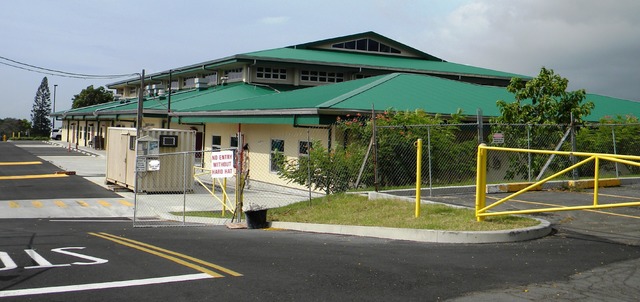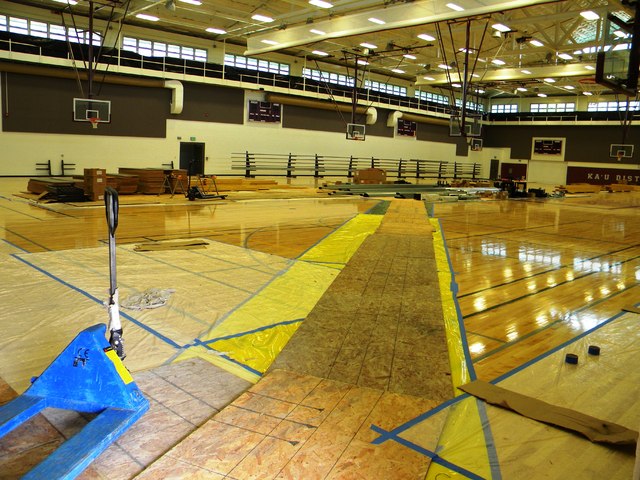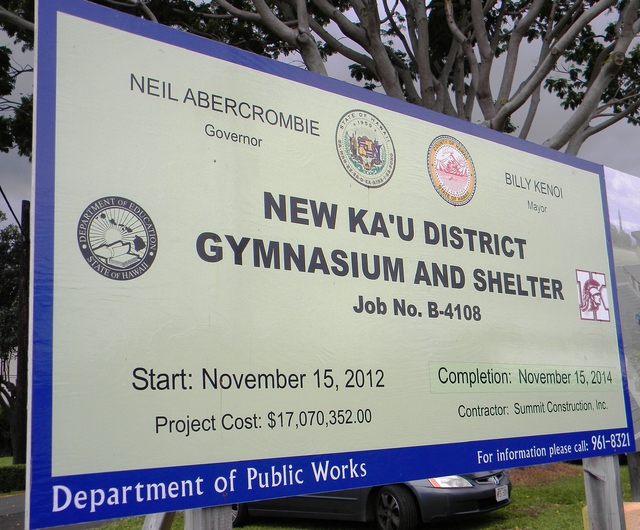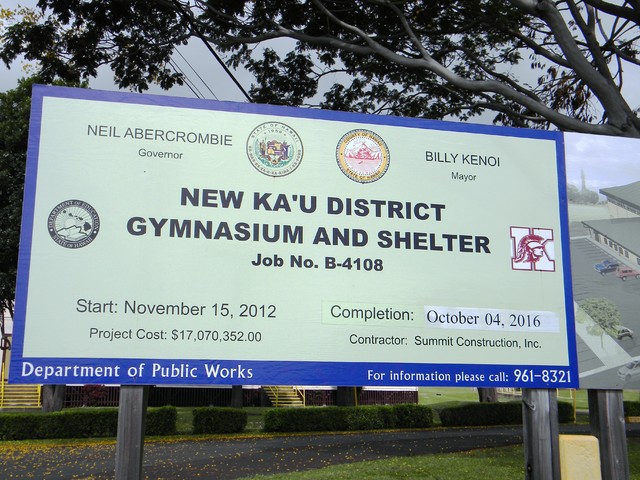OT adds up as county rushes to meet mayor’s deadline




PAHALA — The screech of steel on steel echoed through the cavernous Ka‘u gym Saturday, as contractors worked overtime to meet an Oct. 4 deadline.
More than two years behind schedule and at least $228,000 over budget, the project is becoming the gunk on the track slowing Mayor Billy Kenoi’s sprint to untie as many maile lei as he can before leaving office in early December.
The ceremonial lei untying, Hawaii’s version of a ribbon-cutting, occurs as each public project is deemed ready for use. Kenoi has said it’s one of the most rewarding parts of the job.
The mayor is so intent on seeing the Ka‘u project finished during his tenure, the county has authorized overtime pay for contracted construction workers. That means taxpayers, not contractor Summit Construction Inc., will pick up the tab for the expedited work.
“The pending cost attributed directly to OT is approximately $97,000,” Parks and Recreation Director Clayton Honma said Wednesday in an emailed response to questions. “Please understand that the county is only paying for the overtime premium (the “half” in the “time-and-a-half”) as the contractor’s contract includes the straight-time cost component for the work.”
Honma said to the best of his knowledge, the Ka‘u project is the only one authorized for overtime, or at least, his department hasn’t authorized overtime for any other project. Other projects racing to a finish are the $17 million Hilo Municipal Golf Course improvements and $10.2 million in upgrades to Mauna Kea Park.
He called the OT authorization a “serious investment in the completion of this project,” to provide recreational facilities for the students at Ka‘u High and Pahala Elementary School, as well as the entire community.
The state has provided $18.1 million for the project.
“The school and its students will benefit tremendously in having these facilities provided to them as quickly as possible to support their school-wide assemblies and programs, P.E. activities, culinary programs, additional classroom spaces, sports teams’ practices and matches/games, etc,” Honma said. “The community will have access to new meeting spaces, recreational facilities, new county-directed recreational programs for keiki and kupuna, etc.”
Public Works Director Warren Lee also was unaware of any other OT authorization.
The project was plagued with problems almost from the start. A lava tube and burial site caused delays in grading the site and then last year, the concrete flooring for the 21,069-square-foot gym portion of the 43,300-square-foot building had to be torn out at contractor’s expense and redone when it didn’t pass county inspection.
Kenoi’s frustration with delays escalated to the point that on Aug. 5, he called three Public Works engineers into his office and fired them on the spot, according to several sources within and closely aligned with county government who asked not to be identified because they feared retaliation.
The three employees were called back to work the following week, after being told no formal action was taken. West Hawaii Today is not naming the employees to preserve their privacy.
Kenoi, Lee and Human Resources Director Sharon Toriano declined comment on the grounds employee issues are confidential.
Shortly after that incident, management of the project was transferred from Public Works to Parks and Recreation.
“The Department of Public Works and Department of Parks and Recreation have been working closely together on this project since its inception through the planning and design stages as well as throughout its construction,” Honma said. “The principal administrative duties for the project recently transitioned from DPW to DPR in conjunction with the impending completion of the project in order to facilitate DPR’s occupancy and operation of the facilities.”
Summit Construction was paid an extra $166,069 in a June, 2015, change order that was added to the original $17.1 million contract. The change order was for “unanticipated changes not included in original design,” according to a report to the County Council.
Details of the change order include overhead costs associated with additional time to get State Historic Preservation burial treatment permits, drainage, grading, sidewalk and driveway relocation work, rerouting of telephone lines and other details not specified in the original contract. An earlier change order added $6,937 for the burial treatment plan and locker room material upgrade.
A third change order added 110 contract days to the project, without increasing the cost.
Mitsunaga &Associates Inc., the contractor for architectural and engineering services for the project, was granted an additional $55,091 to its $1 million contract in a Sept. 11, 2015 change order to “perform shelter quality assurance as required.”
Change orders reported to the County Council as of Aug. 31 total 5 percent over the original contract for engineering and 1 percent over the original $17.1 million construction contract. It’s not known if further change orders — such as the one authorizing overtime — still await the mayor’s signature. The administration has not yet responded to a Monday request for public records under the state’s Uniform Information Practices Act.
Two independent experts consulted last week said there’s no set percentage dictated by industry standards. A 2013 report “Auditing construction contract change orders,” by Tony Ollmann, director of Chicago-based accounting and advisory firm Baker Tilly Virchow Krause LLP, calls it a “red flag” when change orders exceed 10 percent.
Change orders are certainly not unusual on large construction projects, said James Bolin, senior executive consultant for Denver-based Long International, a project management consulting company.
“There’s no such thing as a perfect contract or a perfect design,” Bolin said in a Thursday telephone interview.
The facility is hardened for use as a shelter during hurricanes and will also contain a filtered vog safe room for residents to escape hazardous volcanic fog. The shelter is being constructed to withstand a 500-year hurricane, a high Category 3.
It sits on 5 acres of state property makai of the existing school gymnasium. Funding for the project was first approved by the Legislature in 2009 but was then held back by former Gov. Linda Lingle. The money was later re-appropriated and released by Gov. Neil Abercrombie in fall 2011.
The structure includes an auxiliary building, as well as athletic courts, recreation and multipurpose rooms, restrooms, lobby, concession area, storage rooms, a locker and shower room and an athletic training room. It will feature three NCAA regulation size courts. Approximately 29,000 square feet of the building will also serve as an emergency shelter, serving up to 1,928 people.
The shelter was the brainchild of the late Ka’u Democratic state Rep. Bob Herkes. After five years of unsuccessful appeals for $10.9 million from the state Department of Education for a gym for Ka‘u High School and Pahala Elementary School, Herkes renamed it a civil defense shelter, asked for $18.1 million and got the money transferred to the county in hopes of getting it built more quickly.





